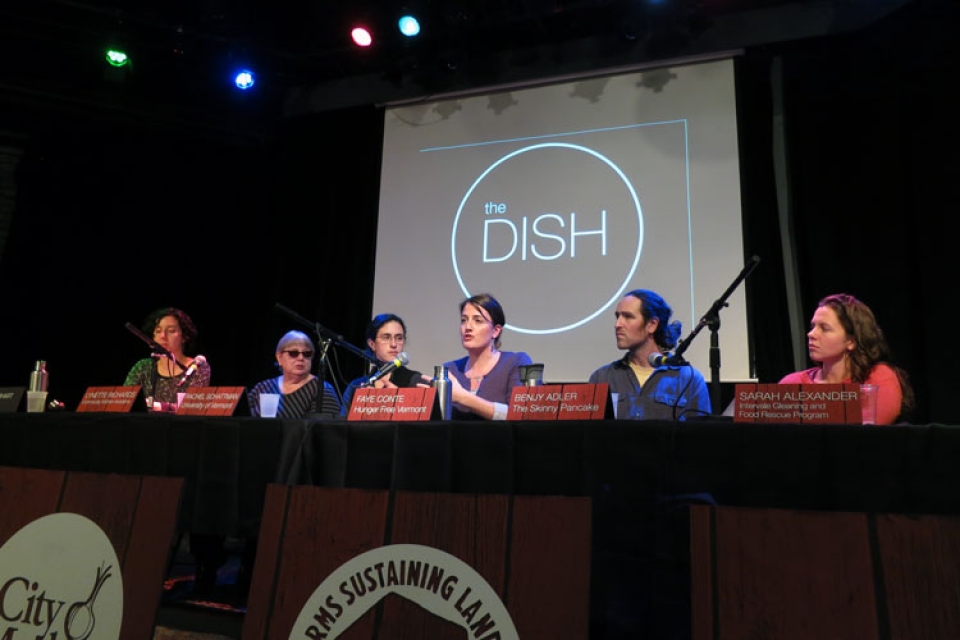Tackling the Topic of Food Access
Our latest Dish panel discussion tackled the tough question of food access in Vermont and explored innovative programs and solutions for increasing food access for Vermonters. When planning for this Dish discussion, we tried to keep in mind that food access is a huge, complicated subject, and that it would take many Dish discussions to fully explore all the different aspects of this topic. So, we narrowed it down to focus specifically on the relationship between the local food system and food access in Vermont. Just because something is local, does that make it more accessible?
Our moderator, Alison Nihart, started by providing the audience with some background information to inform the conversation: 12.6% of Vermont households are food insecure and 85,000 Vermonters are struggling with food insecurity. For comparison, 14% of households are struggling with food insecurity nationally. In Vermont, this means that 1 in 7 Vermonters and 1 in 5 children experience food insecurity on a regular basis.
Not sure what the term food insecurity means? Food insecurity is defined as the lack of access to enough food to fully meet basic needs at all times due to lack of financial resources. Food insecurity with hunger is defined as households in which adults have decreased the quality and quantity of food they consume because of lack of money to the point where they are quite likely to be hungry on a frequent basis, or in which children's intake has been reduced due to lack of family financial resources, to the point that children are likely to be hungry on a regular basis and adults' food intake is severely reduced.
Even though we see food insecurity at a significant rate in our state, our local food economy is growing. Vermont Farm to Plate announced last month that total purchases of local food in the state is up to 6.9% of the total food economy, which is equal to about $189 million in sales. The largest buyer groups of local food are Co-ops and grocery stores, followed by direct farmer or producer sales to consumers.
There is certainly a perception that local food is more expensive, and there is definitely some truth to that perception. This is due to a number of factors, including efficiency of scale, subsidies, distribution, etc (I think I hear some topics for future Dish discussions!), but NOFA-VT found that that wasn’t always the case. In 2010, NOFA-VT did a study comparing the price of 14 local produce items at farmers’ markets to non-local produce, and they found that 36% of conventional products at farmers’ markets were cheaper than non-local items, and they found that the local organic products at farmers’ markets tended to be cheaper overall than non-local items.
Our panelists represented different areas of the food system and provided a wide spectrum of lenses for this multifaceted conversation. They all agreed that food access is a much larger topic than we can discuss in an hour and a half and solving the problem of food access is a systemic political and economic issue.
However, there are programs that can help alleviate some of the pressure in the state. For example, Rachel Schattman, from UVM and Bella Farm, pointed out that even though many farmers are struggling with being able to afford to feed their own families, a number of farmers have found innovative ways to make their food more affordable for people with low-incomes, including partnering with gleaning programs (these programs harvest food that wouldn’t be sellable, but which is still good to eat), instituting a sliding fee scale for their farm stands, and participating in subsidized food share programs (like NOFA-VT’s Farm Share program).
Other innovative programs that our panelists described include:
- The Free Food Share program through the Intervale Gleaning and Food Rescue Program offers free food shares to 125 participants for 16 weeks during the summer and fall.
- Community Kitchen Academy, a 13 week culinary job training Vermont Foodbank program offered at the Chittenden Emergency Food Shelf, teaches people who are unemployed how to cook and work in a commercial kitchen. The students use fresh, local, donated products to prepare meals that are offered at the Food Shelf and Soup Kitchen.
- Crop Cash at Vermont farmers’ markets allows people who use their EBT card to receive additional vouchers for more purchasing power of local food at farmers’ markets.
- Universal meal programming at schools throughout Vermont to provide every child with free meals at school to ensure every child is receiving the nutrition they need and to remove the stigma of only some kids receiving free and reduced price meals.
- Donating leftover meals and ingredients from restaurants to food shelves to decrease food waste and increase the availability of fresh, quality foods at food shelves. Restaurants are protected under Vermont’s Good Samaritan law in regards to the donation of food.
- Offering incentives at retail stores to encourage purchases of healthy foods through fresh fruit and vegetable coupons or vouchers.
- Discount programs at Co-ops, such as City Market’s Food For All program, which provides a 10% discount to anyone receiving WIC, 3SquaresVT, Supplement Security Income, or Social Security Disability.
While these programs won’t fix the food access issue, they are a good way to bridge the gap while trying to address this issue at a national level. And if you want to challenge yourself to see what it is like trying to purchase food with an average 3SquaresVT budget (approximately $37/week for a single person), sign up for Hunger Free Vermont’s 6th Annual 3SquaresVT Challenge, Sunday, November 15 – Saturday, November 21!
If you’d like to catch the full Dish discussion, check out the video!
